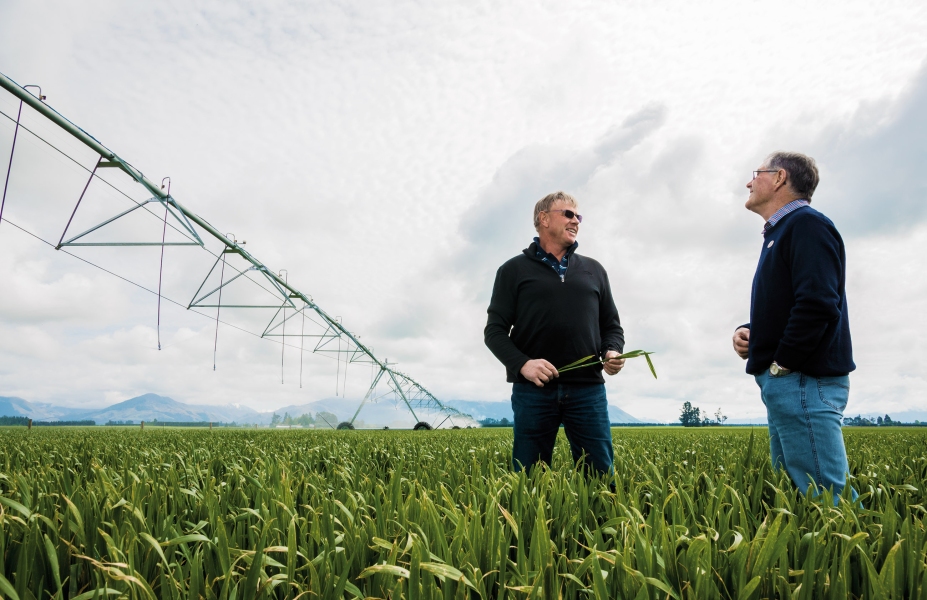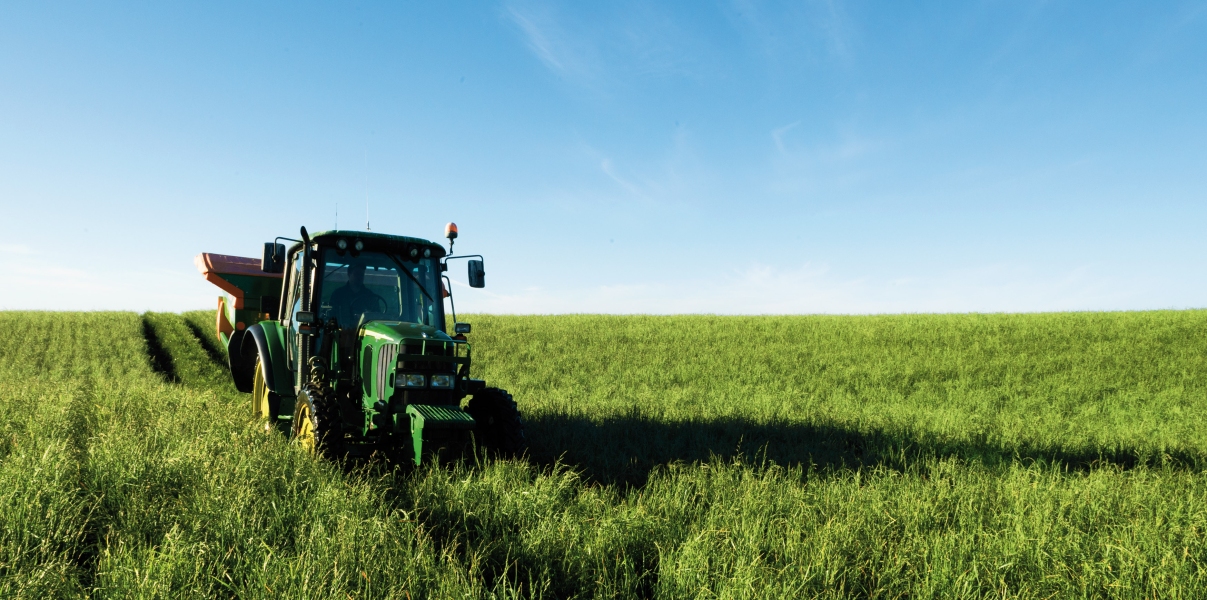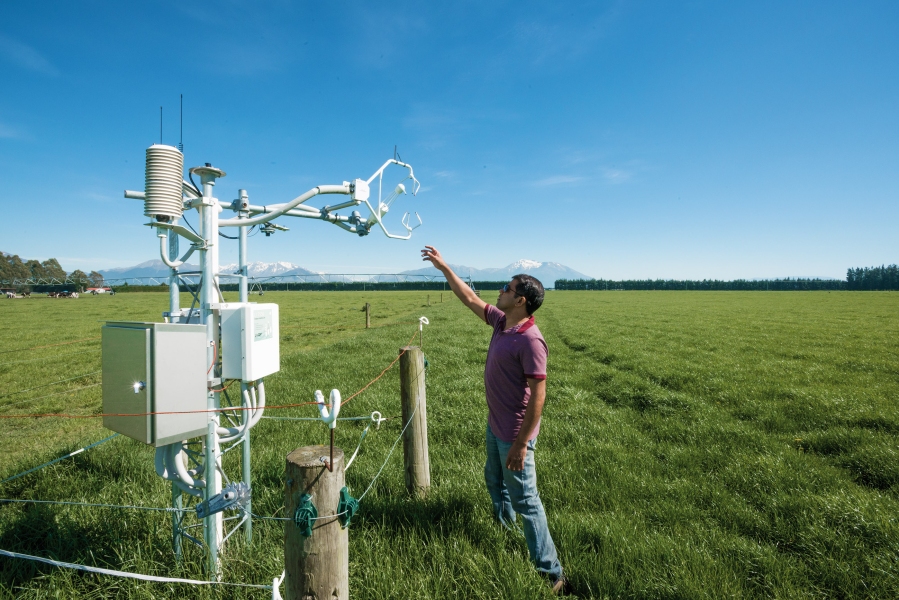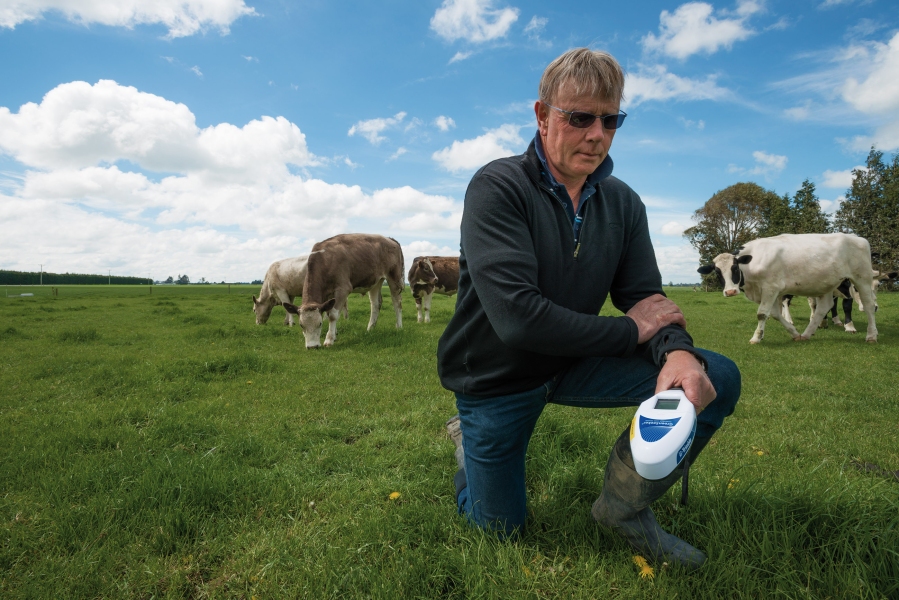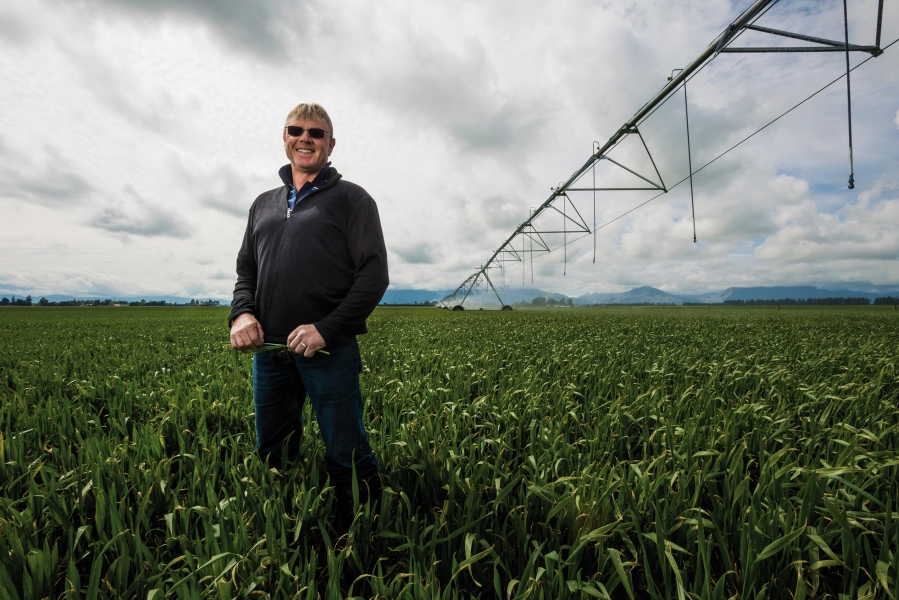New Zealand's farmers face complex – occasionally formidable – challenges in their quest for a productive and sustainable operation. Colin Barkus discovers how science and technology are helping to even the odds.
Craige Mackenzie laughs at the suggestion he's on some sort of crusade to promote science-based farming, or 'precision-ag', as those with an ear for the marketable have dubbed it.
But there's no denying that 'Greenvale' – Mackenzie's thriving intensive arable operation on the upper-Canterbury Plains near Methven – has become New Zealand's 'poster farm' for successful technology-driven agrarian practice. And Mackenzie's the man to whom scientists – NIWA's among them – turn first to test and validate innovations aimed at boosting farm efficiency and sustainability.
A way of life
From a distance, the view of Greenvale and its neighbouring 1200-cow dairy farm, which the Mackenzies half-own, is unremarkable. A tighter focus, however, shows that technology's influence is pervasive.
Aided by latest data from real-time soil moisture tracking sensors, a chain of computer-controlled centre-pivot irrigators inches undeviating along its programmed path, delivering a precise dousing to crops and pasture with scarcely a drop misplaced; a GPS-controlled tractor traverses a paddock with fastidiousness no human driver could achieve, applying fertiliser only where growth is lagging; inquisitive electronic sensors monitor the presence and movement of water in the soil, silently transmitting their findings back to NIWA, where analysis to guide Mackenzie's next applications of water, fertiliser and spray is underway; updated local weather forecasts excite a laptop into life, pointing the way for the next six days of weather-dependent activity on the farm.
Precision-ag is a way of life at Greenvale. Mackenzie is active in a range of partnerships with Crown and private research organisations, all geared towards ensuring farm inputs – water, fertiliser, pest and disease controls – hit the right spot, in the right quantity, at the right time.
Daughter Jemma manages a thriving business, Agri Optics New Zealand Ltd, which designs and builds sensing and mapping technologies that help other farmers do likewise.
"It's a full-on, time-consuming commitment," Mackenzie admits. Which begs the question: why do it?
Multiple benefits
Mackenzie has always had an eye for the innovative. Early adoption of technology – Greenvale was the second farm in the area to irrigate using centre pivots – has helped him and wife, Roz, negotiate challenging times in the past, particularly during Greenvale's conversion from dry-land to arable farming.
"While it is commercially driven," Mackenzie says, "that's not the only reason for doing it. It's actually quite hard to quantify the savings.
"If we look at water, our EM (electromagnetic) mapping technology is showing positive results. By scheduling irrigation based on soil water content, we've been saving, on average, 32 per cent ... up to 50 per cent at this time of year (spring). If you're buying water, that's very significant. And if we factor weather forecasting in, the savings can be even greater.
"The same goes for fertiliser. If you apply (it) only when and where it is needed, of course there'll be savings."
Technology is also helping to mitigate some of farming's perennial challenges, like the weather: extreme and occasionally destructive on the upper plains. In June, snow lay close to a metre deep. In September, a once-ina-generation nor'wester decimated shelter belts in the area and wreaked havoc on unsecured farm equipment – particularly centre-pivot irrigators.
Mackenzie uses 'NIWA forecast', a high-resolution online weather forecasting service, to prepare Greenvale for risks presented by the weather. The farm's irrigation, fertilising and spraying schedules also rely heavily on accurate weather data from NIWA.
"By scheduling irrigation based on soil water content, we've been saving, on average, 32 per cent ... "
But Mackenzie's primary motivation for committing to an approach that baffles some and fully terrifies others is to reduce Greenvale's environmental footprint.
"Over the years, as we've been introduced to new crops, we've also had access to a greater range of fungicides and fertilisers," he explains. "Growing new crops sometimes requires greater inputs. We realised if we didn't manage them properly, they'd have major implications for the environment."
Completing a Nuffield Scholarship in 2008 opened his eyes still wider.
"That was a turning point for me. It was a catalyst for working with organisations like NIWA to find ways to reduce our (environmental) footprint.
"Once I started to understand water-use efficiency, for example, I realised we had a social responsibility to do something about it."
Is there pressure from regulators to walk this path?
"We don't feel it," he says. "If you do nothing, there'll be pressure. But in fact we've spent time with regulators and we're ahead of where they want us to be. We'd rather help shape the future, than be reactive. If you're reactive, generally speaking, you're not making very good decisions."
Two-way learning
Mackenzie says partnerships and personal relationships have been key to identifying technology and practices that genuinely benefit the farm.
"Once you begin using technology, it's amazing who you bump shoulders with," he says. "That's how most of our partnerships started. You build this community of knowledge-sharers.
"We've been fortunate to partner with people who've helped us bring technology together to get the desired result: to combine, for example, results from our lysimeter and eddy covariance trials with local weather forecasts, our own EM soil-mapping technology and variable-rate irrigators, to optimise our water use."
See: The rise and fall of soil moisture
Maurice Duncan and Dr MS Srinivasan, hydrologists at NIWA who've been actively involved in the lysimeter and eddy covariance partnership at Greenvale, say it's a two-way street.
"We learn so much when we come out here," Duncan says. "It's heartening to see someone validating and making such effective use of our science. You see people out there irrigating when they don't need to ... and here's Craige taking up our technology and scheduling irrigation on the basis of soil moisture deficit. That's exactly what we're working towards."
The word is beginning to spread.
Says Mackenzie: "A neighbour looked at what we're doing with EM mapping and variable-rate irrigation, and he's just converted a sheep and beef operation into dairy as a result. Another neighbour has used grid soil sampling and variablerate applicators to spread lime and base fertiliser.
"People learn about what we do and discover that it works; it's sustainable. We measure what we do every step of the way and we can balance it all up and demystify it.
"Doubling output isn't a result of doubling input. It's all down to precision: knowing how much, when and where."
Crusader or not, Mackenzie's message is a compelling one.
The rise and fall of soil moisture
They're not much to look at – a grate-covered hole in the ground containing pipes and a solar-powered electronic rain gauge, and a metal pole bearing sensors that resemble a miniature space probe and contorted robotic hands – but they perform crucial functions.
Greenvale's lysimeter (the hole in the ground) and eddy covariance tower (the pole) are technological twins that help Craige Mackenzie understand exactly what happens to irrigation and rainwater when it hits his paddocks, and schedule sowing, irrigating, spraying and fertilising accordingly.
The lysimeter measures how much – and how quickly – water drains through a contained area of the soil profile. Sensors on the eddy covariance tower measure wind speed and direction, temperature, humidity and CO₂ transfer – factors that determine how much water is lost via evapotranspiration.
What doesn't go down must go up, so the tandem devices provide a complete picture of soil moisture movement on the farm. Soil moisture probes validate their findings.
NIWA's Maurice Duncan and Dr MS Srinivasan are working closely with Mackenzie to ensure data from these devices integrate effectively with other technology on the farm, including an electromagnetic mapping tool used to identify soil types and their differing moistureholding characteristics, and variable-rate irrigators and fertiliser applicators.
A nifty wee device
Cow urine can boost nitrogen levels in grass by a factor of thirty. Telltale patches of lush, deep-green growth collectively cover up to a third of any cow paddock's total area.
"Adding nitrogen-based fertiliser to that third," says Craige Mackenzie, "is pointless and wasteful – and potentially harmful."
That's the philosophy behind 'SmartN': new technology devised by Mackenzie. The system scans and measures the comparative density and height of grass it passes over. A farmer can set a threshold, then programme the SmartN system to apply different amounts of fertiliser to different areas – delivering a precise dose only where Daisy hasn't 'been'.
Growing with the flow
Abundant and accessible fresh water is New Zealand agriculture's greatest competitive advantage, and a key driver of growth in the sector. Scientists and farmers are working together to keep it that way.
Picture of productivity
North Canterbury is a picture of productivity.
Contented dairy herds pull lazily at lush, carpet-flat pastures. Fields of wheat, barley, rye, radish, carrot and pak choi – fat and flourishing – contort in the stiffening nor'easter.
It's a scene that belies the region's relatively meagre annual rainfall and exposure to punishing, desiccating winds. When it turns nor'west, the locals reckon they can see the fields changing colour before their very eyes.
Irrigation water has lent the richness of hue to this landscape.
The region's arable and dairy farmers rely on it – sweat on it – and recognise that any threat to its availability would spell doom for their livelihoods and deliver a body blow to the regional and national economies. Waste it, they acknowledge, and money goes down the drain – literally – and a treasured environment is placed at unacceptable risk.
As a result, north Canterbury's farming community has taken sustainable water use to heart. It's become a primary driver of daily farm routine, and science is helping to point the way.
Mounting pressure
By world standards, New Zealand farmers are literally awash with H₂O. A recent ANZ Bank-commissioned report put this country's annual renewable water supply at 75.6 million litres per capita, compared with 22.5 million in Australia, 10.4 million in Europe, 10.0 million in the US and just 2.1 million in China.
"There's no doubt New Zealand's abundant supply gives us a considerable competitive advantage," says Dr Clive Howard- Williams, NIWA's Chief Scientist, Freshwater and Estuaries. "We're the envy of farmers overseas.
"Even as our climate changes and extreme weather, like the drought of 2013, becomes more common, our agricultural sector is better placed than most to ride it out, stay productive and focus on growth."
But the pressure, he says, is mounting. "Demand is accelerating, driven by economic growth and a widening public expectation that high-quality water should be freely available to all. Sustainable management is becoming increasingly challenging – and sustainability is not an option any more, it's a must."
Industry analysts, as one, identify declining water availability and quality as the top concerns facing farmers and growers worldwide – even in relatively rain-sodden, uncrowded New Zealand. Effective water-management strategies and initiatives are essential, they counsel, if demand is to be satisfied and the uncertainties of a changing climate are to be negotiated.
One such initiative lies behind the dramatic transformation of landscape that's taken place in dry north Canterbury.
Confidence and care
Ngāi Tahu Farming's north Canterbury dairy farms tap into the Waimakariri Irrigation Limited scheme (WIL), a cooperative that draws water from the nearby Waimakariri River and reticulates it, via canals and races, to member farms dotted up and down the plains.
WIL water is carefully controlled, scheduled and monitored. Occasionally it is unavailable altogether, when river flow drops below a critical level.
For Ngāi Tahu Farming Dairy Cluster Manager Shaun Back, confidence flows with it: "Dairying needs water – there's no escaping it. We need enough to ensure the grass grows, and WIL gives us that."
But Back says it's also about a duty of care: "We have to avoid over-watering and creating nutrient-leaching problems. And if we're wasting water, we're threatening the viability of the entire scheme and wasting money."
A partnership with NIWA is helping to strike the right balance.
Early on, NIWA hydrologists Maurice Duncan and Dr MS Srinivasan were asked by WIL administrators to compare the amount of water that members were extracting with the actual 'atmospheric demand': the combined effects of rainfall, wind, humidity and temperature on soil moisture levels.
"We found a big discrepancy," says Duncan. "Most members were irrigating much more than they needed to."
The duo realised the solution lay in providing one-on-one advice and support to members. They recognised the need to install on-farm weather and soil moisture monitoring technology, so that farmers could see for themselves the relationship between the two – and schedule irrigation accordingly.
Ngāi Tahu was one of the first to benefit. "It's been incredibly helpful," says Back. "We can see, especially on the shoulders of the irrigation season, whether it's going to be cold or warm and if rain's on the way, and how soil moisture levels will be affected.
"We needed a simple system to help us work out the right amount of water to put on. It's come together really well. And NIWA has been great at helping us read the data, compare them with other sites and understand what we're looking at."
More to learn
Down the road at Gavin Reed's 225ha property, it's a similar story.
Access to WIL gave Reed, currently chairman of the scheme, the opportunity to convert his dry-land sheep farm into a thriving intensive-cropping operation, with a dairy-grazing unit attached. The property hosts a rain gauge and soil moisture probes, and Reed accesses NIWA forecast's twoand six-day rain and wind predictions at least three or four times a week.
"I'm working out how fast the moisture is getting into the soil. I'm looking at how quickly the soils are drying out, and using that to guide how quickly I need to get back to that paddock with the irrigator."
But, he reckons, there's more to be done, and he's relying on NIWA to keep the good science coming.
"It's a delicate balance. WIL needs 48 hours' notice to shut water off, so I need total confidence that the rain you're forecasting will arrive, before I'll cancel.
"We have to take the water if it's delivered. That can be wasteful."
Srinivasan and Graham Elley, a NIWA Environmental Systems Consultant, acknowledge there are gaps in the weather station network used to generate forecasts for WIL members. The scheme reaches from the coast, where annual rainfall is around 500mm, to the foothills, where as much as 1000mm can fall. Wind, temperature, evaporation and humidity can also vary significantly.
"At the moment we haven't got stations that represent conditions across that entire range," Elley says. "Filling the gaps is a priority for us – so we can take advantage of our high-resolution forecasting capability and give members data tailored as closely as possible to conditions on their property. That will improve their confidence." (See: Where, when and weather)
NIWA is also helping Reed to negotiate issues associated with plans for on-farm or scheme-scale water storage ponds, which will receive WIL water in times of excess and sustain farmers when the scheme can't meet demand directly.
Ice spy
NIWA's scientific eye is now fixed firmly on the place where most of Canterbury's irrigation water begins its journey to the farm paddock: the high-altitude snow and ice fields of the Southern Alps.
NIWA's Snow and Ice Network is helping to quantify highelevation snow and ice and improve understanding of its influence on lower-level river and lake levels, seasonally and longer term. Findings are of direct relevance to irrigators, because large alpine rivers are their supply source.
Sensors at 11 stations dotted strategically along the alpine chain transmit ultrasonic pulses towards the snow surface and measure the time it takes the echoes to return – an indication of distance. As snow accumulates, the distance between the sensor and the snow surface decreases, enabling scientists to work out the depth of the snow that has fallen. Instruments called 'snow pillows' record the weight of the snow. By measuring both depth and weight, scientists can calculate density, which indicates how much water is stored in the snowpack.
The Snow and Ice Network, along with NIWA's advanced numerical modelling capabilities, is enabling researchers to predict how water availability may change in the short term (up to 15 days), seasonally and over longer time scales under a range of future climate scenarios – helping water users plan and prepare.
Where, when and weather
Accurate weather forecasts are good. Accurate and meaningful weather forecasts are better. Accurate, meaningful and always-accessible weather forecasts that support farm productivity and sustainability are unbeatable.
Craige Mackenzie received the phone call late at night, Prague time.
Back home at Greenvale, his farm manager faced a difficult decision: spray for grass grub now in the hope that predicted rain would wash the insecticide down to the grassroots where the destructive pests reside, or wait.
"The locals were saying there's no way the forecast rain would arrive," recalls Mackenzie, who was in the Czech Republic attending a conference. "If they were right, spraying would be an expensive waste of time. But if we didn't get to the grass grub soon, it could set us back a long way."
From his hotel room, he logged into 'NIWA forecast' – a suite of online weather forecasts tailored to Greenvale's particular patch of the upper Canterbury Plains – and checked the latest: "It told me decent rain was on the way at 4.00pm. That was all I needed to know."
Mackenzie instructed his manager to spray. That afternoon, 31mm fell – as it happened, one of very few significant rainfalls that would occur that dry 2011 winter.
Applied weather
Accurate, up-to-date, easy-to-interpret and alwaysaccessible weather and climate data are gold for farmers like Mackenzie.
"NIWA forecast is one of the most important tools in our toolkit," he says. "We use it daily – even several times a day. It's helped us reduce the amount of water we use and prevent leaching out through the soil profile.
"We used about 125mm per hectare (of irrigation water) on our cropping farm last year. That's under half the average for this district. It was similar on the dairy farm."
Dr Murray Poulter, NIWA's Chief Scientist, Atmosphere, and manager of NIWA's online forecasting services, says working with Mackenzie is helping NIWA improve the relevance of its forecasts to farmers and growers.
Within NIWA, he says, "our focus has been on lifting the accuracy and resolution of our forecasting. Two factors contribute: computational power, which we've got in spades with our state-of-the-art supercomputer in Wellington; and the density of our weather station network.
"If we've got stations in the right place, we can supply farmers with forecasts tailored to their place – almost down to farm scale. That's a high priority for us."
Now the partnership with Greenvale, Poulter says, "is helping us see weather through farmers' eyes. It's showing us exactly how farmers apply weather information, how it needs to integrate with other technology to support important water- and risk-management strategies.
"When you've got precise local weather data supporting soil moisture analyses and helping to drive vital tools like variable-rate irrigators that can apply as little as 5mm to one elevated, dry corner of a single paddock ... that's a pretty powerful combination."
Find out more about NIWA Forecast
A heads-up on climate change
During the next 30 years, climate change is likely to have discernible effects on New Zealand's primary sector. As temperatures warm, atmospheric CO₂ concentrations increase and rainfall patterns change, there'll be positive and negative impacts on production.
A collaborative study involving the Ministry for Primary Industries (MPI), NIWA, AgResearch, Plant & Food Research, Landcare Research, Scion and DairyNZ has given the dairy, sheep and beef, broad-acre cropping, horticulture, and forestry industries valuable insight into climate-change impacts they can expect during the next three decades, along with options for adaptation. The study integrated a literature review with sophisticated computer modelling to closely analyse implications for each industry.
Key results are published in a non-technical stakeholder report: Impacts of Climate Change on Landbased Sectors and Adaptation Options, freely available from the MPI website.
Into the future: man and machine
Typically, Craige Mackenzie is thinking ahead.
He's keen on the idea of telemetered real-time soil-moisture data, to replace the weekly analyses currently prepared and sent by NIWA. "We could combine it with NIWA forecast and the ET [evapotranspiration] data, then all of a sudden you've got this hugely powerful tool for managing your irrigation," he says, directing a glance – half expectant, half in jest – at the NIWA scientists in the room.
"We could watch what's happening in the shallow and deep zones of the soil, then build maps for fertilising and spraying and feed them direct to the tractor."
Mackenzie is certain there's more to be gained from the NIWA partnership: more refining of equipment, processes and outputs, and better integration of technology. But there's a cautionary tone in his musings too.
"You've got to be a bit careful," he admits. "There are some folks saying let's automate it all ... send data direct to the irrigator to change the application rate, use algorithms to calculate fertilising rates based on crop sensors ... and so forth.
"My feeling is farm managers need to be making farm management decisions. There's still a lot of assumption involved in some of the automations available. They may not be correct. They still need work.
"Precision farming isn't all about fancy gadgets and complex information. It's about getting the right mix of information and human skills."
Science and technology, Mackenzie concludes, "are there to support us, not replace us. They inform us, they up-skill farmers, but it's a dangerous space if you let them take over entirely. Farmers still need to be 'out standing in their fields'."
At Greenvale, it's a sure bet scientists will be out standing there with him.

